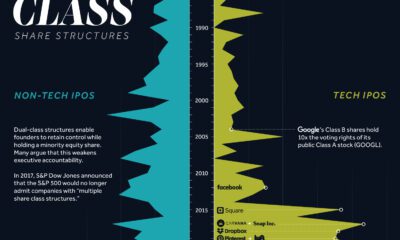
Written By Dorothy Neufeld
Graphics & Design
- Pernia Jamshed
Published May 1, 2023
•
Updated April 28, 2023
•
The following content is sponsored by New York Life Investments
The Recession Playbook: Three Strategies for Investors
Concerns about the economy and trouble in the U.S. banking sector have led to increased market uncertainty.
Before this began to surface, several factors were driving slower returns:
- Inflation: Above-Target
- Interest Rates: Restrictive
- Economic Growth: Below Trend
In this graphic from New York Life Investments, we look at three recession investment strategies that have historically been resilient when the market has faced headwinds.
1. Value Equities
During periods of high inflation and slower growth, value equities have been well-positioned as a recession investment strategy, thanks to the following factors:
- Income generation
- Quality
- High cash balances
- Low correlation to the economic cycle
Value equities include the four most traditional “defensive” sectors, whose earnings are less correlated to economic cycles:
- Real Estate
- Utilities
- Consumer Staples
- Health Care
Not only have these sectors tended to be more resilient in downturns; cash flows from these sectors have been often positively correlated with inflation.
A moderate equity allocation to value equities within a diversified portfolio could help provide resiliency during times of above-trend inflation and below-trend growth.
2. Commodities
In today’s geopolitical landscape, there are a number of factors that may support the commodity sector, including:
- Energy independence
- China’s reopening
- Minerals and metals to fuel green energy
With this in mind, here’s how investors may integrate commodities into their portfolio.
| Traditional 60/40 | Sample Commodities Satellite Portfolio | |
|---|---|---|
| Equities | 60% | 55% |
| Bonds | 40% | 40% |
| Commodities | 0% | 5% |
As the above table shows, the commodities satellite portfolio represented a 5% exposure to commodity firms in the portfolio.
Next, when looking back over a 25-year period, a hypothetical portfolio with a 5% allocation to commodities had a stronger risk-adjusted return than a traditional portfolio. This can be seen in its Sharpe Ratio, which measures the risk-adjusted returns of a portfolio. A higher number is considered better.
| Risk Metrics(Jan 1998-Oct 2022) | Traditional 60/40 | Sample Commodities Satellite Portfolio |
|---|---|---|
| Sharpe Ratio | 0.96 | 1.02 |
| Average Drawdown | -4.2% | -3.7% |
Given these factors, commodities may be positioned for strength.
3. Infrastructure
Infrastructure equities present key benefits as $1.3 trillion is projected in government spending over the next decade across energy, transportation, and broadband sectors.
Here are a few key drivers supporting infrastructure as part of a recession investment strategy:
- High government spending
- Cash flows may be correlated with inflation
- Potentially more stable returns vs. alternative assets
Below, we show how investors can incorporate infrastructure into their portfolios.
| Traditional 60/40 | Sample Infrastructure Satellite Portfolio | |
|---|---|---|
| Equities | 60% | 50% |
| Bonds | 40% | 40% |
| Infrastructure Equities | 0% | 10% |
As we can see, the infrastructure portfolio included a 10% allocation to stocks in the sector. Compared to a traditional portfolio, a portfolio with an infrastructure component had improved risk metrics between the period of January 1998 and October 2022.
| Risk Metrics(Jan 1998-Oct 2022) | Traditional 60/40 | Sample Commodities Satellite Portfolio |
|---|---|---|
| Sharpe Ratio | 0.74 | 0.76 |
| Average Drawdown | -4.5% | -4.3% |
Moreover, the infrastructure sector has been resilient when the market slides. For instance, the Dow Jones Brookfield Global Infrastructure Index outperformed the S&P 500 Index by a wide margin in 2022, 2008, and 2000 when the market faced increased turmoil.
In this way, infrastructure equities may present opportunities for investors looking to diversify their portfolios, especially as a recession investment strategy.
Remaining Resilient With a Recession Investment Strategy
Together, these three strategies may provide investors with more resilience regardless of the stage of the economic cycle:
- Value Equities
- Commodities
- Infrastructure
Thanks to each of their specific attributes, investors can equip themselves with a recession investment strategy that may help offset the unexpected swings of the market cycle.
Learn more about all-weather strategies with New York Life Investments.

Please enable JavaScript in your browser to complete this form.Subscribe to our free newsletter and get your mind blown on a daily basis: *Sign up
Related Topics: #infrastructure #commodities #economic cycle #New York Life Investments #portfolio allocation #portfolio risk #government spending #recession investment strategy #value stocks #high inflation #slower economic growth
Click for Comments
var disqus_shortname = "visualcapitalist.disqus.com";
var disqus_title = "The Recession Playbook: Three Strategies for Investors";
var disqus_url = "https://www.visualcapitalist.com/sp/the-recession-playbook-three-strategies-for-investors/";
var disqus_identifier = "visualcapitalist.disqus.com-157384";
You may also like
-

Environment3 days ago
Visualizing the Biomass of All the World’s Mammals
When the world’s biomass—the stuff we’re made of—is tallied up, humans and cattle outweigh wild mammals by a massive margin.
-

Technology4 days ago
How Smart is ChatGPT?
We visualize the performance of ChatGPT in various professional and academic exams, highlighting the improvements of GPT-4 over GPT-3.5.
-

Politics7 days ago
Mapped: The State of Democracy Around the World
How many countries globally are true democracies? This map showcases the state of democracy in every country worldwide.
-

Datastream1 week ago
How Gen Z Feels About Its Financial Future
Despite the looming uncertainty, members of Gen Z maintains an optimistic outlook about their financial future
-

Automotive2 weeks ago
Global EV Production: BYD Surpasses Tesla
This graphic explores the latest EV production data for 2022, which shows BYD taking a massive step forward to surpass Tesla.
-

Datastream2 weeks ago
More U.S. Tech Companies are Adopting Unequal Dual-Class Voting Structures
Dual-class share structures are rising in popularity, and they give executives much more voting power within a public company.
Subscribe
Please enable JavaScript in your browser to complete this form.Join the 380,000+ subscribers who receive our daily email *Sign Up
The post The Recession Playbook: Three Strategies for Investors appeared first on Visual Capitalist.